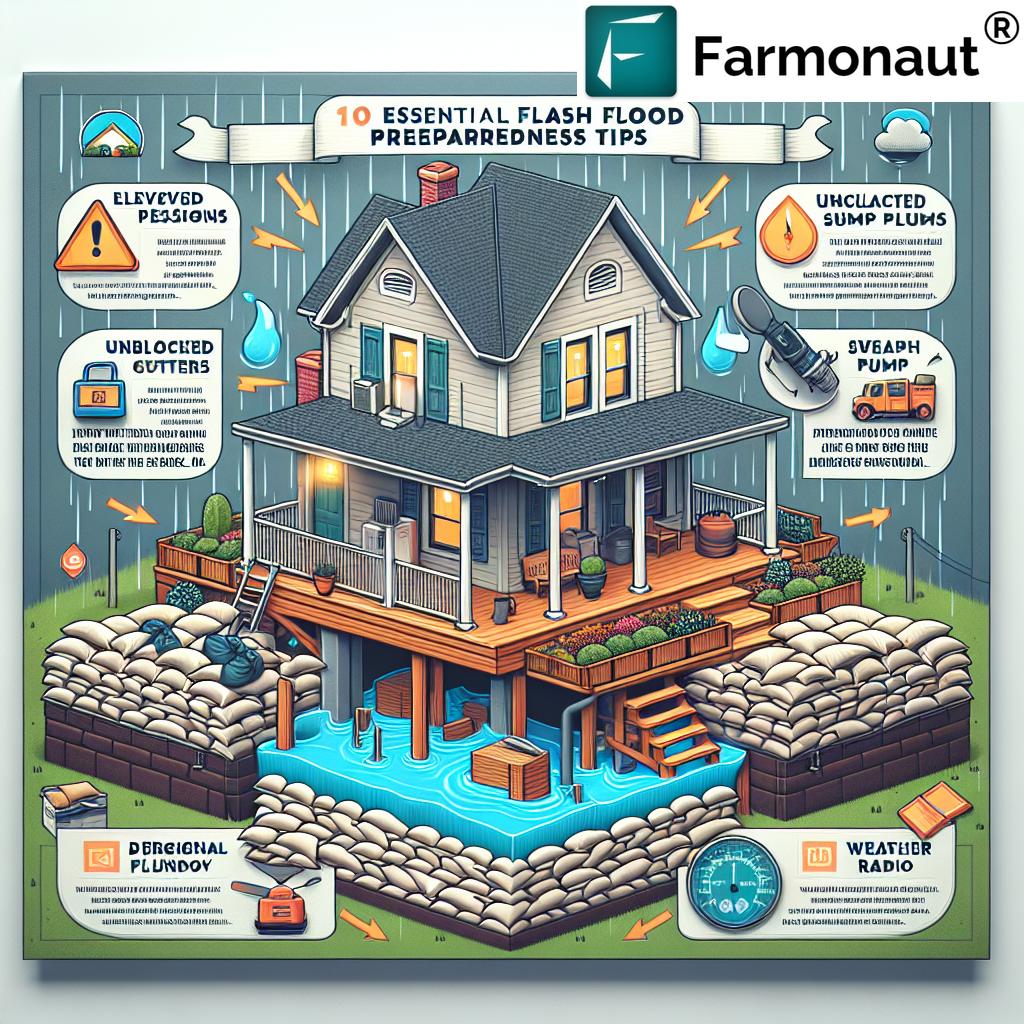10 Essential Flash Flood Preparedness Tips for Cincinnati and Northern Kentucky: Protect Your Home and Stay Safe

“Cincinnati’s April showers have led to a 75% increase in flood risk, with the Ohio River nearing critical levels.”
As we face an unusually wet April in the Cincinnati and Northern Kentucky regions, it’s crucial that we’re prepared for potential flash floods. The Cincinnati weather forecast warns of severe rainfall and possible flash floods, prompting emergency management to issue alerts across the Tri-State area. With saturated soil conditions and the Ohio River at risk of flooding, we must take preventive measures to protect our homes and stay safe.
In this comprehensive guide, we’ll provide you with 10 essential flash flood preparedness tips to help you navigate this challenging weather situation. We’ll also explore how technology, including tools like Farmonaut’s satellite-based weather monitoring, can assist in managing and mitigating flood risks.
Understanding the Current Situation
Before we dive into our preparedness tips, let’s take a moment to understand the current weather situation in Cincinnati and Northern Kentucky.
- The Tri-State area is experiencing unusually heavy April showers.
- Soil conditions are already saturated from previous rainfall.
- The Ohio River is at risk of flooding.
- Emergency management teams are on high alert.
- Local authorities are monitoring potential road closures in Northern Kentucky.
Given these conditions, it’s essential that we take proactive steps to prepare for potential flash floods. Let’s explore our 10 essential preparedness tips.
1. Clear Drains and Gutters
One of the most crucial steps in flash flood preparedness is ensuring that your home’s drainage systems are functioning correctly. Clogged drains and gutters can lead to water accumulation around your property, increasing the risk of flooding.
- Remove leaves, twigs, and other debris from gutters and downspouts.
- Check that downspouts are directing water away from your home’s foundation.
- Clear any blockages from street drains near your property.
- Consider installing gutter guards to prevent future clogs.
By maintaining clear drainage paths, you’re giving excess water a chance to flow away from your property, reducing the risk of localized flooding.
2. Elevate Valuables
With the increased risk of flooding, it’s crucial to protect your valuable belongings by moving them to higher ground. This is especially important for items stored in basements or low-lying areas of your home.
- Move electronics, important documents, and sentimental items to upper floors.
- Use waterproof containers for items that can’t be moved.
- Elevate appliances and furniture on concrete blocks if they can’t be relocated.
- Consider installing shelving units in flood-prone areas for long-term storage solutions.
Taking these steps can help minimize damage to your belongings in case floodwaters do enter your home.
3. Check Your Flood Insurance Policy
Now is the time to review your flood insurance policy to ensure you have adequate coverage. Standard homeowners insurance often doesn’t cover flood damage, so it’s essential to have a separate flood insurance policy.
- Review your policy details and coverage limits.
- Understand what is and isn’t covered under your policy.
- Consider increasing your coverage if necessary.
- Document your belongings with photos or videos for potential claims.
Remember, there’s typically a 30-day waiting period for new flood insurance policies to take effect, so don’t wait until flooding is imminent to review your coverage.
4. Stay Informed with Weather Updates
Keeping up-to-date with the latest weather information is crucial during periods of potential flooding. In Cincinnati and Northern Kentucky, there are several reliable sources for weather updates and emergency alerts.
- Sign up for Hamilton County’s “Alert HC” system for real-time weather alerts.
- Follow local news stations and their weather apps for frequent updates.
- Monitor the National Weather Service’s Cincinnati office for official forecasts and warnings.
- Use weather monitoring tools like Farmonaut’s satellite-based weather data for additional insights.
By staying informed, you can make timely decisions to protect your family and property.
5. Prepare an Emergency Kit
Having an emergency kit ready can make a significant difference during a flash flood event. Your kit should contain essential items to sustain you and your family for at least 72 hours.
- Non-perishable food and bottled water
- First aid supplies and necessary medications
- Flashlights and extra batteries
- Battery-powered or hand-crank radio
- Important documents in a waterproof container
- Change of clothes and sturdy shoes
- Personal hygiene items
- Cash and emergency contact information
Keep your emergency kit in an easily accessible location and make sure all family members know where it is.
6. Create a Family Emergency Plan
Developing a family emergency plan ensures that everyone knows what to do in case of a flash flood. This plan should include:
- Designated meeting places (both in your neighborhood and outside your area)
- Emergency contact information for all family members
- Evacuation routes from your home and neighborhood
- A communication plan in case family members are separated
- Roles and responsibilities for each family member during an emergency
Practice your emergency plan regularly to ensure everyone is familiar with it.
“Emergency services in the Tri-State area have reported a 50% surge in weather-related road closure alerts.”
7. Know Your Flood Risk
Understanding your property’s flood risk is essential for adequate preparation. In Cincinnati and Northern Kentucky, several factors contribute to flood risk:
- Proximity to the Ohio River and its tributaries
- Local topography and drainage patterns
- Historical flood data for your area
You can check your flood risk using FEMA’s Flood Map Service Center or by contacting local flood management authorities. For more detailed insights, consider using Farmonaut’s carbon footprinting tool, which can provide valuable data on soil moisture levels and potential flood risks.
8. Prepare Your Home’s Exterior
Taking steps to protect your home’s exterior can significantly reduce flood damage:
- Install backflow valves on sewer and septic tank connections
- Apply waterproof sealants to basement walls
- Ensure your sump pump is working correctly and consider a battery-powered backup
- Secure outdoor furniture and decorations that could be swept away by floodwaters
- Consider installing flood barriers for doors and windows
These measures can help prevent water from entering your home and reduce potential damage.
9. Be Aware of Road Closures
With the potential for flash floods, it’s crucial to stay informed about road closures in Cincinnati and Northern Kentucky. The Kentucky Transportation Cabinet has reported several closures due to recent severe weather:
- Kentucky Route 8 near Garfield Avenue (Campbell County)
- Kentucky Route 547 between 8 Mile Road and Kentucky Route 8 (Campbell County)
- Licking Pike at Alysheba Drive (Campbell County)
- Washington Trace Road (Campbell County)
- Scott Street between Fourth Street and Fifth Street (Kenton County)
- Kentucky State Route 467 from Sparta to Glencoe (Gallatin County)
Always check for updated road closure information before traveling and never attempt to drive through flooded roads. Remember: Turn Around, Don’t Drown!
10. Utilize Technology for Preparedness
In today’s digital age, we have access to powerful tools that can aid in flood preparedness. One such tool is Farmonaut’s satellite-based farm management solutions. While primarily designed for agricultural use, these tools can provide valuable insights for homeowners in flood-prone areas:
- Real-time weather data and forecasts
- Soil moisture level monitoring
- Vegetation health indices that can indicate oversaturation
By leveraging these technologies, you can gain a more comprehensive understanding of the environmental conditions that may contribute to flooding in your area.

Flash Flood Preparedness Checklist
| Preparedness Action | Priority Level | Completion Status |
|---|---|---|
| Clear drains and gutters | High | [ ] |
| Elevate valuables | High | [ ] |
| Check flood insurance policy | High | [ ] |
| Monitor local weather updates | High | [ ] |
| Prepare emergency kit | High | [ ] |
| Create family emergency plan | Medium | [ ] |
| Know your flood risk | Medium | [ ] |
| Prepare home’s exterior | Medium | [ ] |
| Be aware of road closures | Medium | [ ] |
| Utilize technology for preparedness | Low | [ ] |
Additional Resources
To further enhance your flash flood preparedness, consider exploring these additional resources:
- Farmonaut’s Web App: Access real-time satellite imagery and weather data for your area.
- Farmonaut’s API Developer Docs: For developers interested in integrating weather data into their own applications.
- Farmonaut’s Android App: Get mobile access to crucial weather and environmental data.
- Farmonaut’s iOS App: For iPhone users looking to stay informed on-the-go.
Earn With Farmonaut
Earn 20% recurring commission with Farmonaut’s affiliate program by sharing your promo code and helping farmers save 10%. Onboard 10 Elite farmers monthly to earn a minimum of $148,000 annually—start now and grow your income!
For more information, check out this video:
Farmonaut Subscriptions
FAQ Section
Q: What should I do if my home starts flooding?
A: If your home starts flooding, prioritize safety. Move to higher ground immediately. If you have time, turn off electricity and gas supplies. Don’t attempt to swim or drive through floodwaters. Call emergency services if you’re in immediate danger.
Q: How can I protect my pets during a flash flood?
A: Include your pets in your emergency plan. Prepare an emergency kit for them with food, water, and any medications. Ensure they have proper identification. If you need to evacuate, never leave them behind.
Q: What’s the difference between a flash flood watch and a flash flood warning?
A: A flash flood watch means conditions are favorable for flash flooding. A flash flood warning means flash flooding is imminent or already occurring. Take immediate precautions when a warning is issued.
Q: How can Farmonaut’s technology help with flood preparedness?
A: Farmonaut’s satellite-based technology provides real-time weather data, soil moisture information, and vegetation health indices. This can help you better understand environmental conditions that may contribute to flooding in your area, allowing for more informed decision-making.
Q: Are there any long-term steps I can take to reduce flood risk on my property?
A: Yes, consider improving drainage systems, installing flood barriers, elevating your home if it’s in a high-risk area, and maintaining a healthy lawn to improve water absorption. Always consult with local authorities and professionals before making significant changes.
Conclusion
As we face the challenges of potential flash flooding in Cincinnati and Northern Kentucky, it’s crucial that we stay prepared and informed. By following these 10 essential flash flood preparedness tips, we can better protect our homes, our families, and our communities.
Remember, flash floods can develop quickly and with little warning. Stay vigilant, keep an eye on local weather updates, and don’t hesitate to take action if flooding threatens your area. By working together and leveraging available resources and technologies, we can enhance our resilience in the face of these natural hazards.
Stay safe, Cincinnati and Northern Kentucky!
















